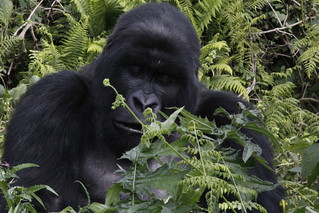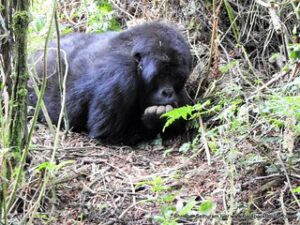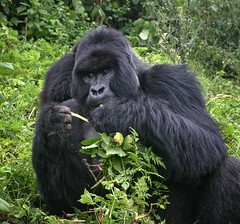Nestled in the northern part of Bwindi Impenetrable National Park lies an outstanding region of the park known as the Buhoma sector. From, the establishment of Bwindi National Park, Buhoma was the pioneer of the mountain gorilla trekking activity with the first gorilla habituated family Mubare gorilla family in 1993. This sector is known for scenic landscapes, dense forests, and rich biodiversity that attract nature lovers from around the world.
Even with the opening of other tracking trails like Ruhija, Rushaga, and Nkuringo, this sector remains the most booked destination. Being an attractive sector has led to the establishment of several accommodations ranging from luxurious, midrange, and budget-friendly lodges in addition to camping sites which has greatly helped to improve the livelihoods of the people in the neighbouring communities, especially the Batwa tribe.
Tracking gorillas in Buhoma sector
Gorilla trekking is one of the most popular activities in the Buhoma sector of Bwindi Impenetrable National Park. This is an activity that allows humans to access the mountain gorillas in their natural habitat. the gorilla tracking experience starts with an early morning briefing at the park headquarters where game rangers and guides provide the trekkers on the dos and don’ts of the gorilla trekking experience. Actual trekking takes 1-5 hours depending on the location of the gorilla family.
on encounter, trekkers are allowed one hour with the gentle giant great apes as you enjoy seeing them play, feed, groom, interact with one another, and observe their behaviour in human presence. In this hour, trekkers are also allowed to take flashless photos after which you leave the forest, but you will always live to remember the challenging expedition.
Gorilla families in Buhoma
Buhoma sector currently has 5 gorilla families ready for tracking thus making an availability of 40 gorilla trekking permits since 8 people above 15 years are allowed to visit the mountain gorillas in their natural habitat daily.
The gorilla families include:
Mubare gorilla family
This is the oldest gorilla family that was habituated in 1991 and first trekked in 1993. The family comprises of 6 members with one dominant silverback called Maraya, 3 adult females, and 2 infants. The family got its name from the Mubare Hills.
The family comprised 12 members at the time of habituation in 1991 but later in 2012, Ruhondeza the dominating silverback died due to old age and was replaced by Kanyonyi. Some members left the group, and they remained only five. After some time, four other members joined the group thus increasing to 9 members.
Kanyonyi later sustained injuries after falling from a tree after violent attacks and fighting from Malaya and was hence unable to protect and defend the family, from then Malaya took over leadership of the family. this family is known for male intolerance and stiff competition for leadership. This group is very convenient for trekkers who do not want to move longer distances into the jungles of the park as it resides close to Buhoma sector park headquarters.
Habinyanja gorilla family.
This is another gorilla family in the Buhoma sector. This family was discovered near a swamp hence the name Habinyanja meaning Nyanja. Habituation of this family was done from 1997 and trekking started in 1999. This family is well known for being so adventurous as it keeps on wandering beyond its friendly grounds which makes trekkers spend more than 6 hours on the search. Like humans, gorilla families also split into form new families. After six years of habituation time the family split and formed the Rushegura group. Currently, Habinyanja gorilla family has 18 members with two silverbacks and babies.
Rushegura gorilla family
Researchers named this gorilla family after the ‘Ebishegura’ a species of trees commonly found in the area where this family was always spotted. This family was habituated in 2000, and tracking started in 2002 after breaking away from the Habinyanja group.
This group is commonly spotted in community gardens and the compound of lodges near the headquarters of the park. this makes it easy to track. Visitors who are unable to move longer trekking distances are allocated to track this family.
The Rushegura gorilla family comprises Kabukojo as the dominant silverback, 3 blackbacks, 5 adult females, 2 sub-adults 6 juvenile males, and 6 infants making 21 members. Their distant location to the park headquarters does not guarantee quick sight of the gorillas, trekkers must be well prepared for the tracking exercise.
Katwe gorilla family
This family was formed by some members who broke away from the oldest family Mubare. The family got its name from the hillside(the top) location where its habituation process started in January 2018. As new births and exits happen within the gorilla families, current records show that the group has 9 members.
So interesting, the group has two adult females, Kashundwe and Malaika who were formerly members of the Mubare family. and other members including 2 blackbacks, 2 mature females, 2 sub-adults, and juveniles with Mahaane as the leading silverback.
Binyindo gorilla family
This is the group that was last studied and added to the other gorilla families in the Buhoma sector in 2019. The habituation process for this family took over 3 years and comprises 6 members that are led by dominant silverback Binyindo. Other members are 2 females, 2 sub-adults, and 1 infant. This family is always tracked using the Ivi River trail along the Sarambwe Nature Reserve bordering Congo.
Cost of trekking gorillas in Buhoma
Like in other sectors of Bwindi Impenetrable National Park and the sister park where gorilla tracking is done, a gorilla trekking permit legally issued by Uganda Wildlife Authority to any sector is $800 per foreign non-resident, $700 for non-foreign residents and 300,000 UGX for east African citizens. Gorilla permits are issued to visitors of 15 years and above and only 8 people are allowed to visit a habituated gorilla family per day and spend one hour in the natural wilderness with the gorillas.
How to get to the Buhoma sector.
The Buhoma sector can be accessed by both road and air transport. When you decide to use air, book a scheduled or chartered flight from Entebbe International Airport or Kajjansi Airstrip to Kihihi Airstrip, then connect to Buhoma by road.
When you opt for road transport travel from Kampala or Entebbe via Masaka-Mbarara to Kabale then connect to Buhoma. The journey takes 8-9 hours.
Alternatively, you can reach the Buhoma sector from Queen Elizabeth National Park through the Ishasha sector for 3-4 hours or from Rwanda via Katuna border and drive for 4-5 hours to Buhoma.
Other activities in Buhoma sector.
Apart from gorilla trekking, Buhoma sector has more activities to offer, and these include.
Guided nature walks: This is another way of exploring the park on foot along well-defined paths(trails). Nature walks are always carried out with the guidance of trained game rangers to ensure the safety of both the wild animals and humans (trekkers). Along the trails, expect to see various animal and bird species. Below are some of the tracking trails in Buhoma sector.
Munyanga river trail
This is one of the natural wonders in the Buhoma sector that provides adventurous nature walks. The trail is scenic with a lush tropical environment with distinguished wild creatures. along this trail, you catch sight of flourishing waterfalls and unique animals including L’hoest monkeys, black and white colobus monkeys, bush elephants, and beautiful butterflies among others. As you walk along this trail you may luckily spot gorillas. Birding safaris can be successful when you hike along this trail and some of those that can be spotted include, blue-headed sunbird, Chapin’s flycatcher, red-faced woodland warblers, and many others.
Muzabajiro hill trail
Having a guided nature walk along the Muzabajiro hill trail is another way of exploring Bwindi’s impenetrable National Park in the Buhoma sector. A professional and trained game guide leads you through the park jungles as you traverse the park on foot. A traveler takes 3-4 hours to complete this trail and as you move, there are chances of meeting different birds, animals, and plants.
Ivy river trail
This trail is found between the Buhoma and Nkuringo sectors. It is a scenic trail that is 14km long and it takes travelers 4-6 hours to complete it. The Ivy River trail brings to encounter with the Batwa community. Different wild creatures can be seen along the trail like animals and water sources. Animals to see include, buffalos, wild pigs, giant forest hogs, blue monkeys, and olive baboons among others. several bird species and butterflies can be spotted.
Rushura hill trail
This is an amazing trail that begins at the park headquarters through Bwindi Impenetrable Park to Rushura Hill which is the highest point of the Buhoma sector. The trail takes 3-4 hours through the thick forest park. This trail helps catch clear sights of the Virunga volcanos, the western rift valley, and the Rwenzori ranges.
Birding
Bwindi National Park is not only known for being home to mountain gorillas but also a top birding destination. This park hosts over 360 bird species including migratory birds, forest birds, and Albertine Rift Valley endemics. Bird watching in Buhoma sector can be best done along the different trails through guided nature walks. Some of the trails include Habinyanja trail, Muzabajiro Loop trail, Rushura Hill trail, Waterfall trail, and Munyanga river trail.
During the bird-watching experience, travelers must be accompanied by experienced park guides who will help to provide more information about the park, name different bird species and you will luckily spot some animals. Bird species that can be spotted along the trails include, the brown-capped weaver, paradise flycatcher, African hill-babbler, blue-headed sunbird, Klaas’s cuckoo, common bulbul, cape wagtail, ross’s turaco, Cassin’s flycatcher, African olive pigeon, sooty falcon, Mackinnons shrike, Rwenzori batis, Blue-headed sunbird, grey crowned crane and many others
Accommodations in Buhoma.
Buhoma sector has several accommodation facilities ranging from luxury, and midrange to budget. Some of them include, Mahogany Springs Lodge, volcanoes Bwindi Forest Lodge, Buhoma community rest camp, Sanctuary Gorilla Camp, Buhoma Haven Lodge, Engangi Lodge, Buhoma Lodge, Silverback Lodge, and many others.
Related safari package for Tanzania northern circuits and beyond
[/vc_column_text][/vc_column][/vc_row]
10 Day Wildebeest and gorillas vacation safaris

Embark on a captivating journey through the heart of East Africa as we invite you to explore the enchanting landscapes, vibrant cultures, and rich biodiversity of Rwanda and Tanzania. This meticulously crafted 10-day itinerary promises an immersive experience, seamlessly blending the awe-inspiring encounters with gorillas
| TRIP DETAILS |
| REQUEST INFO |
6 Day Wildebeest and gorilla trekking safari

Book 6 Days Ngorongoro crater visit and Rwanda gorilla trekking to explore Tanzania & Rwanda on an Africa Safari experience tailored by Active African vacation the leading Safari operator in Uganda. The 6 Days Tanzania Rwanda Safari takes you to the great Ngorongoro crater reserve for an amazing wildlife experience.
| TRIP DETAILS |
| REQUEST INFO |
7 Day Rwanda-Tanzania vacation safari

Depending on the degree of lodging, the time of year, and the particular parks and activities included a 7-day safari in Rwanda and Tanzania might have somewhat different costs. Along with activities to do in every park, below is a sample schedule including expected expenses for middle-class, budget, and luxury alternatives.
| TRIP DETAILS |
| REQUEST INFO |



